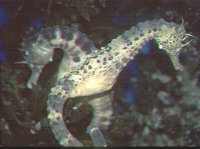| in the kelp forest carnivore species can hide in ambush in the leaves or cruise along beneath the seaweeds looking for food.
Most fish in the kelp forest are carnivores including Seahorses and Seadragons, Wrasse, Scaly fin, Leatherjackets, Old wives, and a number of small rays and sharks such as Port Jackson Sharks (Heterodontus portusjacksoni), Catsharks (Parascyllium spp.), and Wobbegongs (Orectolobus spp.).
There are also a large number of invertebrates that are active carnivores including a number of carnivorous snails such as the Tulip shell (Pleuroploca australasia), whelks such as the Cartrut shell (Dicathais orbita), |

Big-bellied Seahorse
(Hippocampus abdominalis) |